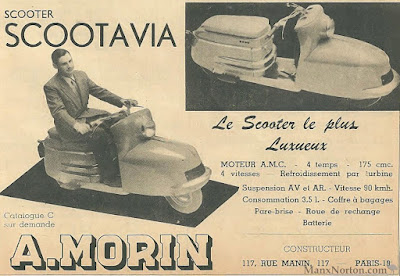Ever heard of the Bond brand before? Does it have any relationship with James Bond? Of course, it has no related to the famous fictional figure of James Bond, but they have similarities, both are the same coming from England.
Well, the owner of this brand is a British company named 'Sharps Commercials Ltd.' which was founded by Paul Sharp in 1922 and based in Preston, Lancashire. The company at the beginning known as a retail motor trading company.
|
1958 Bond P1 scooter powered by 148 cc engine. (Picture from: http://bit.ly/2qGqUVf) |
 This British manufacturer began its work in the automotive world by producing an economical three-wheeled vehicle in early 1949 which was named Bond Minicar due to the machines initially were designed and produced by Lawrence Bond. After that, the mass production of the minicar was carried out from 1949 to 1966 with a total production of 26,500 units (ranging from Minicar Mark-A to Mark-G).
This British manufacturer began its work in the automotive world by producing an economical three-wheeled vehicle in early 1949 which was named Bond Minicar due to the machines initially were designed and produced by Lawrence Bond. After that, the mass production of the minicar was carried out from 1949 to 1966 with a total production of 26,500 units (ranging from Minicar Mark-A to Mark-G). |
| 1949 Bond Minicar Mark-A. (Picture from: http://bit.ly/33plJGb) |
 |
| 1949 Bond Minibyke powered by 98 cc engine. (Picture from: http://bit.ly/2OXElbs) |
 This uniquely shaped motorcycle originally used a 98cc Villiers Mk1F engine. Due to construction problems on the front fork. Then a number of improvements were made, but at least partially successful and a De-Luxe version was soon introduced powered by a 125 cc JAP engine and in November 1950 the design and manufacturing rights were sold to Ellis Ltd of Leeds who continued production until 1953.
This uniquely shaped motorcycle originally used a 98cc Villiers Mk1F engine. Due to construction problems on the front fork. Then a number of improvements were made, but at least partially successful and a De-Luxe version was soon introduced powered by a 125 cc JAP engine and in November 1950 the design and manufacturing rights were sold to Ellis Ltd of Leeds who continued production until 1953. |
| 1952 BAC Liliput powered by 98 cc engine. (Picture from: http://bit.ly/2qLowfV) |
 |
| 1952 BAC Gazelle scooter powered by 122 cc engine. (Picture from: http://bit.ly/2QYKZk3) |
 |
| Lawrence Bond astride one of his lesser-known designs back in 1955 called Sherpa scooter. (Picture from: http://bit.ly/34xiLAV) |
Bond refused to give up and present new models of scooters including P1, P2, P3, and P4. The P1 scooter model powered by a 148 cc Villiers Mk 31C engine and featured fiberglass bodywork, was rolled out in 1958 shortly to be followed by a similar-looking 197 cc Villiers Mk9E engined sister the P2, but sales were slow.
 |
| 1958 Bond P1 scooter powered by 148 cc engine. (Picture from: http://bit.ly/2qGqUVf) |
 |
| 1959 Bond P3 scooter powered by 197 cc engine. (Picture from: http://bit.ly/2R2vSGm) |
Once again, the success is not at the rendezvous and the manufacturer decides to cease its two-wheeled vehicle production in 1962. However, the brand continues its activities as a car manufacturer until the mid-70s (in 1964, the company renamed to Bond Cars Limited) with more or less successful before disappearing altogether.😢
Kept spur your adrenaline on the power of the two-wheeled monster and stay alive with true safety riding. May God will forgive Your sins and
so does the cops...... *** [EKA | FROM VARIOUS SOURCES | SCOOTERHOOD | GRACEGUIDE | BONDSCAR.NET | WIKIPEDIA | LE REPAIRE | FLICKR | MOTORBIKE SEARCH ENGINE]
Note: This blog can be accessed via your smart phone.








































